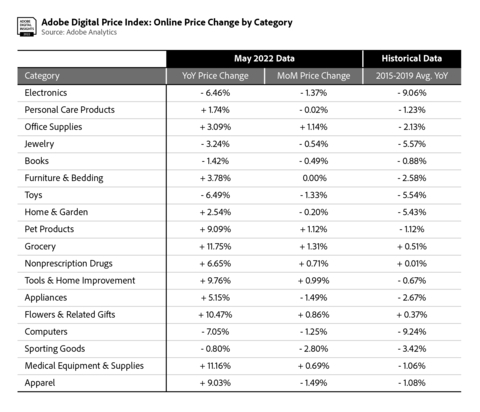Adobe Digital Price Index: Online Inflation Continues to Slow in May at 2.0%
-
Prices dropped
0.7% month-over-month; majority of product categories saw price decreases -
Consumers spent
$78.8 billion $1 billion - Food costs remain high, with groceries overtaking apparel as top category for rising prices

(Graphic: Business Wire)
Prices for electronics and apparel, major categories that made up
In May, consumers spent
“Despite the modest increase in consumer spending online, an uncertain economic climate and rising costs in core areas like groceries are putting a hamper on overall demand,” said
“E-commerce data has become an important input for measuring inflation as daily activities, including shopping, become more and more digital,” said economist
The DPI provides the most comprehensive view into how much consumers pay for goods online, as e-commerce expands to new categories and as brands focus on making the digital economy personal. Powered by Adobe Analytics, it analyzes one trillion visits to retail sites and over 100 million SKUs across 18 product categories: electronics, apparel, appliances, books, toys, computers, groceries, furniture/bedding, tools/home improvement, home/garden, pet products, jewelry, medical equipment/supplies, sporting goods, personal care products, flowers/related gifts, non-prescription drug and office supplies.
In May, 12 of the 18 categories tracked by the DPI saw YoY price increases, with groceries rising the most. Price drops were observed in six categories: electronics, jewelry, books, toys, computers and sporting goods.
Eight of the 18 categories in the DPI saw price increases MoM. Price drops were observed across 10 categories including electronics, personal care products, jewelry, books, toys, home/garden, appliances, computers, sporting goods and apparel.
Notable categories in the Adobe Digital Price Index for May:
-
Electronics: Prices were down
6.5% YoY (down1.4% MoM). This is the largest YoY drop for the category sinceMay 2020 , when prices were down6.8% YoY. As the biggest category in e-commerce by share of spend, price movements have an outsized impact on overall inflation online.
-
Apparel: Prices were up
9% YoY (down1.5% MoM). While the category has now seen 14 months of online inflation, reversing a predictable pattern of heavy discounting periods, there are continued signs that prices are beginning to ease; prices increased12.3% YoY in April,16.3% YoY in March and16.7% YoY in February.
-
Toys: Prices were down
6.5% YoY (down1.3% MoM), the largest YoY drop for the category sinceDecember 2019 before the COVID-19 pandemic, when prices were down10% YoY during the holiday shopping season. This is also the 14th consecutive month of deflation for the category as prices rose0.2% YoY inMarch 2021 .
-
Groceries: Prices continued to surge and rose
11.7% YoY (up1.3% MoM), setting another new record on an annual basis. This follows a10.3% YoY increase in April, a9% YoY increase in March and a7.6% YoY increase in February—all record highs. This makes the first month where groceries have risen more than apparel, which had consistently been the top category for over a year. Groceries remains the only category to move in lockstep with the CPI on a long-term basis, with online prices rising now for 28 consecutive months.
Methodology
The DPI is modeled after the Consumer Price Index (CPI), published by the
Powered by Adobe Analytics, Adobe uses a combination of Adobe Sensei, Adobe’s AI and machine learning framework, and manual effort to segment the products into the categories defined by the CPI manual. The methodology was first developed alongside renowned economists
About Adobe
Adobe is changing the world through digital experiences. For more information, visit www.adobe.com.
© 2022 Adobe. All rights reserved. Adobe and the Adobe logo are either registered trademarks or trademarks of Adobe in
View source version on businesswire.com: https://www.businesswire.com/news/home/20220609005263/en/
Adobe
kfu@adobe.com
Adobe
belkadi@adobe.com
Source: Adobe







